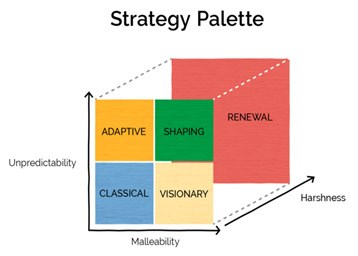-
It's no secret the pace of change today is head-spinningly fast. The stakes are higher than ever: one third of US public corporations will not survive the next five years. In the declining number of industries that remain stable and predictable, the classical approach to strategy and leadership taught in business schools still applies.
But one size no longer fits all situations. Leaders who want to win will increasingly need to match their strategic approach to the environments they face.
"Leaders who want to win will increasingly need to match their strategic approach to the environments they face."
Martin Reeves, Senior Partner The Boston Consulting Group and Director Bruce Henderson InstituteIt's clear the same considerations apply to Australian enterprises. In fact, with its heavy dependence upon the currently volatile resource sector and susceptibility to shifts in the Asian and global economy, one might argue that Australian companies need to be especially agile in applying the right approaches.

In my book Your Strategy Needs a Strategy I introduce the 'strategy palette', a tool that helps executives classify the competitive environments and then identify the relevant strategic approach for each.
We describe five distinct approaches to strategy and execution defined by three environmental characteristics: unpredictability, malleability and harshness.
- The classical approach is the traditional analyse-plan-execute method, with a goal of achieving sustainable competitive advantage through scale or differentiation. It is the right approach for stable environments.
- The adaptive approach is about responding rapidly to changing market conditions by continuously experimenting and then selecting and quickly scaling up whatever works.
- The visionary approach — the strategy of entrepreneurs — envisions and realises new business possibilities. Although this approach is typically associated with small start-ups, large companies now often also need to be visionary to stay relevant in the face of frequent disruptions by maverick competitors.
- The shaping strategy is about partnering with other companies to reshape an entire industry through collaboration, often using a digital market platform. Companies deploying this approach think about building and shaping multi-firm ecosystems.
- Finally, the renewal strategy is the option to choose when a business is in jeopardy and needs to conserve its resources to fund the journey back to viability and growth.
Adding another layer of complexity, most large companies compete in more than one environment or in ones that shift over time. Leaders increasingly need to lead by deploying the right approaches and resources across these diverse areas.
They need to create a pattern of distinct approaches across the business, keeping it up-to-date by asking the right questions and by putting their weight behind critical change initiatives. It's more an exercise in constant self-disruption than one of perfecting an unchanging recipe for success based on past experience.
Successful CEOs understand this. Pfizer's Ian Read, for example, reorganised the company by defining new business units around products facing similar market challenges, so each unit could develop the culture and capabilities needed to win.
Pepsico's Indra Nooyi runs and reinvents the company at the same time by deploying 'disruption' teams that work in parallel with the day-to-day operations teams in each part of the business.
Google's recently announced reorganisation is also motivated by the need to deploy different approaches to strategy and execution in different parts of their business.
The strategies and roles you take on as a leader will depend on how complex and dynamic your business is. The goal is always to mix, match and evolve your company's capabilities and resources in response to the world changing around you. That is the ultimate leadership strategy.
Martin Reeves is senior partner at The Boston Consulting Group and director of the Bruce Henderson Institute.
To read more about Your Strategy Needs a Strategy, click here. To download the iPad app, click here.
The views and opinions expressed in this communication are those of the author and may not necessarily state or reflect those of ANZ.
EDITOR'S PICKS
-
I recently enjoyed a coffee with a treasurer of a major US firm in Dubai. She is a leader I admire (and in fact I'm trying to encourage her to write the next version of 'lean-in' or 'pull out' :) ). We became involved in discussing how we both lead virtual teams located around the world and what we have learned.
27 February 2015 -
Traditional leaders tend to focus our attention on developing only the 'best' people or those with the highest level of potential. This assumes we know how to find talent based on textbook selection criteria and processes. But are we overlooking our future leaders because we are not looking in the right places?
4 June 2015 -
Launched in the United Kingdom in 2010 with the goal of achieving 30 per cent women on FTSE-100 boards by the end of 2015, the 30% Club migrated to Australia earlier this year with events in Sydney and Melbourne.
29 September 2015
